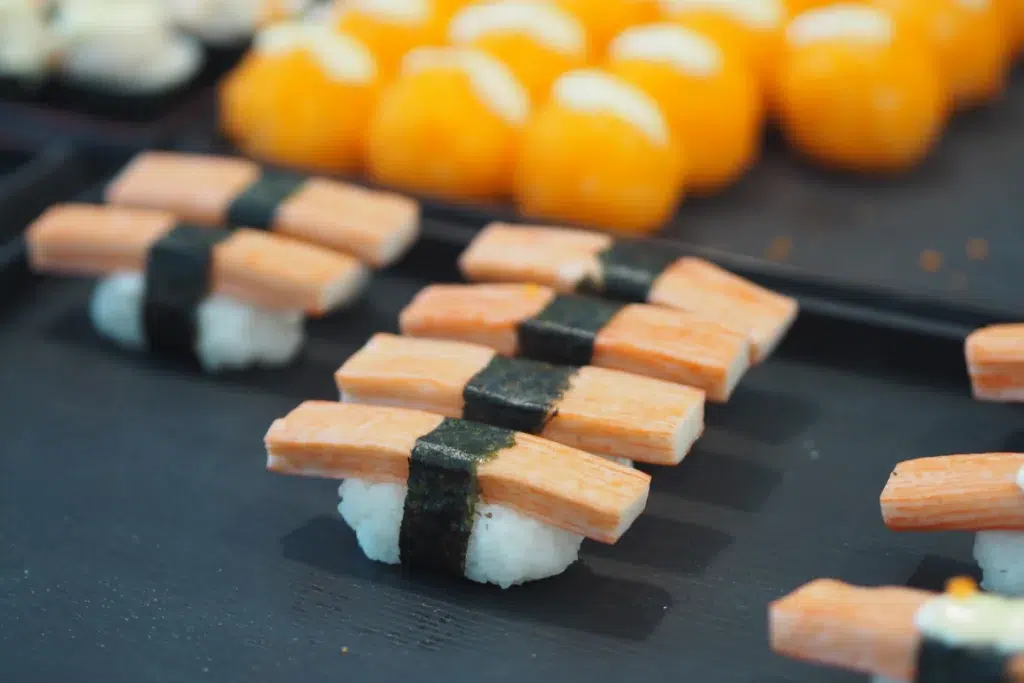
Introduction to Kani in Sushi
Kani, signifying crab in Japanese, stands as a pivotal ingredient in the sushi experience. It uniquely enhances both flavor and texture. First and foremost, it’s essential to highlight that kani significantly enriches sushi varieties. Consequently, this section aims to shed light on its pivotal role, exploring both its significance and various manifestations.
The Historical Roots of Kani in Japanese Cuisine
Tracing back, the story of kani within Japanese culinary traditions is both rich and intriguing. Originally, sourced from Japan’s rich coastal ecosystems, kani swiftly ascended to become a culinary favorite. Subsequently, its incorporation into sushi signified a notable evolution within this gastronomic art form.
On the one hand, we have the luxurious kani sushi, celebrated for its fresh, tender crab meat. On the other hand, there’s the widely enjoyed kani kama, or imitation crab. Thus, each variant offers distinctive flavors and textures, catering to diverse tastes and preferences.
Moreover, delving into the world of kani allows us to appreciate the depth it adds to sushi’s harmony and balance. Whether it’s enjoyed in the refined elegance of a kani nigiri or the comforting simplicity of a kani roll, kani in sushi is a testament to the celebration of flavors that transcend culinary boundaries.
For those interested in further exploration, the following resources offer additional insights:
- The History of Sushi, which provides a comprehensive look into sushi’s ascendancy as a global culinary delight.
- Understanding Japanese Cuisine, where readers can discover the vast richness of traditional Japanese dishes.
- Nutritional Benefits of Seafood, highlighting the myriad health benefits of including seafood, such as kani, in one’s diet.
In summary, our journey through the multifaceted world of kani in sushi is only beginning. Next, we will delve into its historical importance, contemporary adaptations, and nutritional contributions. Therefore, join us as we continue to explore the essence of kani, a humble ingredient that captures the very soul of sushi and the richness of Japanese culinary tradition.
Kani Varieties and Their Culinary Uses
In the world of sushi, kani shines through its diversity. Indeed, this versatility is a testament to its culinary value. In this section, we explore the different types of kani and their unique roles in sushi dishes.
Real Crab vs. Imitation Crab
Firstly, understanding the distinction between real crab and imitation crab is crucial. Real crab, known for its tender, succulent texture and rich flavor, elevates sushi to new heights. Conversely, imitation crab, crafted from processed seafood known as surimi, offers an accessible and cost-effective alternative without compromising much on taste.
Popular Kani-Based Sushi Dishes
Furthermore, kani finds its way into a plethora of sushi creations. For instance, kani nigiri, featuring a slice of real or imitation crab atop vinegared rice, showcases kani in its simplest form. Additionally, kani rolls, such as the California roll, blend kani with other ingredients like cucumber and avocado, offering a harmonious mix of flavors.
Equally important, the spicy kani salad serves as a refreshing side dish or appetizer. It mixes shredded kani with spicy mayo, cucumber, and sometimes mango, thus creating a burst of flavors that cleanse the palate and prepare it for more sushi delights.
Nutritional Profile of Kani
Kani not only adds flavor and texture to sushi but also brings nutritional benefits. Real crab meat is rich in protein and omega-3 fatty acids, supporting heart and brain health. Imitation crab, while not as nutrient-dense as real crab, still provides a decent source of protein and is lower in calories, making it a suitable option for those watching their dietary intake.
To sum up, the journey through the varieties of kani in sushi reveals a world of culinary creativity and nutritional value. As we move forward, understanding these distinctions enriches our appreciation for sushi and highlights the versatility of kani as an indispensable ingredient in Japanese cuisine.
How to Enjoy Kani in Sushi
Embracing kani in sushi offers a spectrum of culinary experiences, each inviting a deeper appreciation for this ingredient. Indeed, the way one enjoys kani can vary significantly, reflecting personal tastes and cultural traditions.
Traditional vs. Modern Ways of Enjoying Kani
Traditionally, kani is savored in its most natural form, allowing its subtle flavors to shine through. Dishes like kani nigiri and kani sashimi are celebrated for their simplicity and elegance. On the other hand, modern sushi creations often incorporate kani in more inventive ways. Rolls like the California roll and spicy kani salad mix kani with a variety of ingredients, offering a new dimension of taste and texture.
Tips for Selecting and Preparing Kani
When selecting kani, freshness is key for real crab, while quality matters for imitation crab. For those preparing sushi at home, ensuring that the kani is properly handled and stored is crucial to preserve its delicate flavor. Moreover, experimenting with different kani varieties in sushi can lead to delightful culinary discoveries.
Kani in Sushi Culture and Etiquette
Kani‘s place in sushi is not just about taste; it’s deeply embedded in Japanese culture and etiquette. Understanding these aspects enriches the dining experience, offering a glimpse into the ceremonial nature of sushi eating.
The Cultural Significance of Kani
Kani is more than a food ingredient in Japan; it’s a symbol of sophistication and seasonal celebration. Especially during festivities, kani dishes are a common sight, reflecting the ingredient’s esteemed status in Japanese cuisine.
Sushi Etiquette Related to Kani
When eating sushi featuring kani, certain etiquettes enhance the experience. For instance, it’s customary to appreciate the sushi’s appearance and aroma before tasting. Dipping kani sushi lightly in soy sauce, without overwhelming its natural flavors, is also part of the etiquette, showing respect for the chef’s craftsmanship.
FAQs About Kani in Sushi
Kani raises questions and sometimes even puzzles diners. Here, we aim to clear up some common queries, enhancing your knowledge and enjoyment of kani in sushi.
What’s the Difference Between Kani and Surimi?
Firstly, understanding that kani means crab meat, while manufacturers use surimi to create imitation crab (kani kama), is crucial. Real kani delivers a unique, sweet flavor and tender texture. On the other hand, surimi, a product made from white fish, seeks to replicate this taste and texture, offering a more accessible crab meat alternative.
Can You Eat Kani Raw in Sushi?
Typically, chefs cook real crab (kani) to ensure food safety, rarely serving it raw in sushi due to pathogen risks. However, cooked crab stars in sushi dishes like kani nigiri or kani rolls, maintaining safety without compromising the exquisite kani flavor.
How Do You Identify Quality Kani in Sushi Restaurants?
While dining, seeking sushi spots known for freshness and quality becomes vital. Fresh, high-quality kani will exhibit vibrant color and a firm texture. Moreover, restaurants that meticulously source their ingredients or highlight seasonal kani dishes likely promise a superior dining experience.
How Does Kani Influence the Taste of Sushi?
Kani significantly enhances sushi’s flavor profile with its sweet and delicate taste. Real crab adds a touch of luxury and depth to sushi dishes, while imitation kani offers a similarly pleasant taste that complements the other ingredients in sushi rolls and salads.
What Are Some Creative Ways to Include Kani in Sushi?
Creative chefs often experiment with kani beyond traditional sushi rolls. For example, they might incorporate it into sushi burritos, sushi bowls, or even kani tempura for a crispy texture. These innovative dishes showcase kani‘s versatility in sushi cuisine.
The Essence of Kani
Understanding kani in sushi is to appreciate the art of sushi itself. Discover the rich history and culinary significance of kani, exploring how this ingredient shapes the sushi experience.
Varieties of Kani
Kani manifests in two primary forms: the authentic crab meat savored for its natural sweetness and the widely used imitation crab, celebrated for its adaptability and flavor. Dive into the top imitation crab recipes for delicious and easy seafood dishes that highlight the versatility of kani.
Culinary Uses of Kani
From the classic kani nigiri to the beloved California roll, kani plays a starring role in an array of sushi dishes. Learn how to incorporate this ingredient into your sushi making, whether you’re a seasoned chef or a home cook. Uncover the best ways to enjoy imitation crab meat in your sushi and beyond.
Part 6: Conclusion
As we conclude, exploring kani in sushi has unveiled the ingredient’s significant contribution to Japanese cuisine and culture. From its various forms and health benefits to its enjoyment methods and associated etiquette, kani exemplifies culinary artistry and cultural legacy.
Ultimately, whether you are deeply familiar with sushi or newly exploring it, deepening your understanding of kani will enrich your dining experience. It connects you to the age-old traditions of Japanese cuisine and the modern innovations that keep kani at the heart of sushi creativity worldwide.
So, the next time you relish a sushi dish, take a moment to appreciate the kani it features. Contemplate the journey this humble yet impactful ingredient has made from the ocean to your plate, capturing the essence of sushi and the breadth of Japanese culinary tradition.
By shifting to more active voice constructions, this revision aims to bring energy and immediacy to the narrative, ensuring that the text not only informs but also captivates the reader’s interest.
